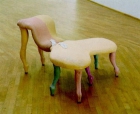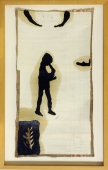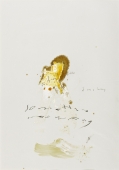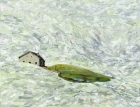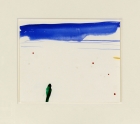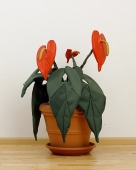
Artist | Max Mohr (*1962)
https://www.artist-info.com/artist/Max-Mohr
Biography
Biography
born 03.10.1962 in Frankfurt am Main
1982 - 1989 Städelschule Frankfurt a. M. bei Christa Näher
1989 - 1990 Institut für Neue Medien, Frankfurt a. M. bei Peter Weibel
1990 - 1993 Atelier in Offenbach bei Frankfurt
1993 - 1994 Stipendium der Hessischen Kulturstiftung, Atelier in New York
1994 - heute Atelier in Köln
Exhibitions
Exhibitions
1988 Galerie Ute Paduhn, Düsseldorf
1989 Luis Campana, Frankfurt a.M.
1991 Luis Campana, Frankfurt a.M.
1991 Luis Campana, Köln
1992 Museum für Moderne Kunst (Szenenwechsel), Frankfurt a.M., Katalog
1992 Luis Campana, Köln
1993 Galerie Transit, Leuven
1994 Galerie Gilles Peyroullet, Paris
1995 Max Protetch, New York
1996 Galerie Art-Concept, Nizza
1997 Galerie Art-Concept, Paris
1997 Galerie Arndt & Partner, Berlin (August)
1997 Attitudes, Geneve (September)
1997 Kunstraum Hübner, Frankfurt a. M. (September)
1998 Max Protetch, New York (Frühjahr)
About the work (english / deutsch)
About the work (english / deutsch)
A Piece of Furniture, called Brusching Up
A piece of furniture that is irritating. It has now been standing for some weeks in the Museum für Moderne Kunst in Frankfurt and I have repeatedly been watching the visitors. Some hardly take note of it, others stop in their tracks in front of it, then circle around it - the men were thoughtful, furrowing their brows or with afine smile, while the women tended to be amused. A group of young Japanese women at first giggled, then discussed it - I could not understand what they were saying their hands describing movements in space. The day after Max Mohr had installed his piece of furniture in the museum, I went home and took two voluminous books down off the shelves: The Erotic Arts by Peter Webb (London, 1975) and The Complete Book of Erotic Art by Phyllis and Eberhard Kronhausen (New York, 1978). Because I wanted to find out on which furniture artists of erotic portrayals have placed their protagonists. As viewers of such portrayals we tend to look at the way love is being made rather than at the substructure on which the act of love is being carried out.
I was somewhat disappointed at how unimaginative the artists were. Depending on the cultural background, they opted for either a simple wooden frame or heavy bedding. And that hardly makes the work of the lovers any easier: The contortions thus needed in order to put everything on display were not inconsiderable. Would it not have been, so I asked myself, simpler to build special platforms for all the different positions for making love? The artists would not only have facilitated their own work, they would above all have made the comings and goings easier for the lovers. As early as the descriptions given by the Marquis de Sade, it is hard to imagine how people accomplished the unions of which he writes, that is unless you are well practiced in making tantric love.
The piece of furniture Max Mohr has made is not easy to describe. It is 125 cm long, has a broad, arched back that is curved softly towards the back (83 cm high) and two wide seats (50 cm highly, 110 cm broadly) in the form of a backside. It stands on eight staunch female legs, which, or so we can assume, ensure stability. The seat and the two hindmost legs are covered with a perforated, flesh-colored plastic material, as is customarily used for orthopedic aids. The sand-colored back and the remaining legs, which are pink and sky-blue, are covered with elastic.
Max Mohr’s piece of furniture is cunning. You circle around it, try to imagine all the possible positions for love it would accommodate, and yet come to no satisfactory conclusion.
I believe this is exactly what the artist intended. The furniture mobilizes our erotic imagination, in order in the final analysis simply to be identical with what it is or what we associated with it. The item contains the display of the act of physical love in form, material and contents. It is a medium for its own erotic ideas.
Is this really the case? Can we be sure of this?
Is the furniture not cunning precisely because it by no means reveals all its secrets to us: Perhaps it contains mysteries which have not yet even found a place in our imaginations?
If Max Mohr ambiguously and ironically sets out the act and the form of the act before our very eyes, then this resembles what the first person narrator in Hans Joachim Schädlich’s Versuchte Nähe (Attempted Closeness) (Hans Joachim Schädlich, "Versuchte Nähe",1971; in: Komm mein Geliebter, gehen wir aufs Land und nächtigen in den Dörfern, Hamburg, 1977, S.53) does on the acoustic plane: "And then I myself told Janko, I believe, that she screams." And this fact creates difficulties: "l know, but what should I do," says the first person narrator to Janko, „the neighbors have complained to me, as has the janitor, what are you doing with the girl, or they come banging on my door, and on my ceiling, knocking on their floors until I start to think the ceiling is about to fall on my bed; you try doing it."
German text by Jean-Christophe Ammann / Translation by Jeremy Gaines
(Extract - Full printed version available in the Museum)
MMK - Museum für Moderne Kunst, Frankfurt am Main
Ein Möbel, genannt Aufmöbeln
Ein Möbel, das irritiert. Es steht nun schon seit einigen Wochen im Museum für Moderne Kunst in Frankfurt und immer wieder beobachte ich die Besucher. Die einen nehmen es kaum zur Kenntnis, die anderen verharren davor, umkreisen es; die Männer nachdenklich, stirnrunzelnd oder mit feinem Lächeln, die Frauen eher belustigt. Eine Gruppe junger Japanerinnen kicherte zuerst, dann diskutierten sie - ihre Sprache konnte ich nicht verstehen -, mit ihren Händen zeichneten sie Bewegungen in den Raum.
Am Tag, nachdem Max Mohr sein Möbel im Museum installiert hatte, ging ich nach Hause und holte aus meiner Bibliothek zwei voluminöse Bücher heraus: The Erotic Arts von Peter Webb (London 1975) und The Complete Book of Erotic Art von Phyllis und Eberhard Kronhausen (New York 1978). Ich wollte nämlich herausfinden, auf welchen Möbeln Künstler erotischer Darstellungen ihre Protagonisten festhalten. Als Betrachter solcher Darstellungen schaut man meistens auf die Art und Weise des Liebesaktes und weniger auf den Unterbau, auf dem dieser vollzogen wird. Ich wurde ziemlich enttäuscht ob der Einfallslosigkeit der Künstler. Je nach Kulturkreis wechselten sich einfache Holzgestelle mit schwerem Bettzeug ab. Das erleichtert keineswegs die Arbeit der Liebenden: Die Verrenkungen um der Zurschaustellung willen sind nicht unbeträchtlich. Wäre es, so frage ich mich, nicht einfacher gewesen, für all die verschiedenen Liebespositionen adäquate Untergestelle zu bauen? Damit hätten die Künstler sich, vor allem aber den Liebenden, die Arbeit erleichtert. Schon bei der Schilderung des Marquis de Sade sind viele Vereinigungen schlicht nicht nachvollziehbar, außer man ist im tantrischen Liebesvollzug geübt.
Das Möbel von Max Mohr ist nicht einfach zu beschreiben. Es ist 125 cm lang, besitzt eine breite, sanft nach hinten gewölbte Rückenlehne (83 cm hoch) und zwei weitausladende Sitze (50 cm hoch, 110 cm breit) in Form eines Gesäßes. Es steht auf acht strammen Frauenbeinen, die, so ist anzunehmen, Stabilität garantieren. Sitzfläche und die beiden hintersten Beine sind mit einem perforierten, fleischfarbenen Kunststoffmaterial bezogen, wie es handelsüblich im orthopädischen Bereich verwendet wird. Die sandfarbene Rückenlehne und die rosa und himmelblauen restlichen Beine sind mit Elastan bespannt.
Das Möbel von Max Mohr ist ein listiges. Man umkreist es, versucht, sich alle möglichen Liebespositionen vorzustellen, und kommt zu keinem befriedigenden Schluß.
Ich glaube, dies ist genau die Absicht des Künstlers. Das Möbel mobilisiert unsere erotische Phantasie, um am Schluß nur mit sich selbst bzw. seinem Assoziationsradius identisch zu sein. Das ausgestellte Möbel beinhaltet die Zurschaustellung des Liebesaktes in Form, Material und Inhalt. Es ist Träger seiner eigenen erotischen Vorstellungen. Ist das wirklich der Fall? Können wir uns dessen sicher sein? Besteht die List des Möbels nicht auch darin, daß es uns längst nicht alles preisgibt: Vielleicht enthält es Geheimnisse, die sich noch gar nicht in unserem Vorstellungsvermögen eingenistet haben?
Wenn uns Max Mohr vieldeutig und ironisch Handlung und Form der Handlung vor Augen führt, so tut dies der Ich-Erzähler in Hans Joachim Schädlichs Versuchte Nähe (Hans Joachim Schädlich, "Versuchte Nähe",1971; in: Komm mein Geliebter, gehen wir aufs Land und nächtigen in den Dörfern, Hamburg, 1977, S.53) auf der akustischen Ebene: „Und dann habe ich Janko, glaube ich, selber erzählt, daß sie schreit.“ Das gibt Schwierigkeiten: „Ich weiß, aber was soll ich machen“, sagte der Ich-Erzähler zu Janko, „im Haus sind sie mir schon auf die Bude gerückt, der Hauswart, was machen sie mit dem Mädchen, oder sie donnern an meine Tür, und über mir, die klopfen aufn Fußboden, daß ich denke, mir kommt die Decke aufs Bett, da mach was.“
Text von Jean-Christophe Ammann
(Auszug - Der vollständige Text ist als Informationsblatt beim Museum erhältlich)
MMK - Museum für Moderne Kunst, Frankfurt am Main
Bibliography
Bibliography
Ammann, Jean-Christophe: Max Mohr. Endlich verständlich. Verlag Wilk, Friedrichsdorf, 1992.
ISBN: 3-9803053-0-9
 offers / Requests offers / Requests  |
About this service |
|---|
 Exhibition Announcements Exhibition Announcements  |
About this service |
|---|
 Visualization |
Learn more about this service | ||
|---|---|---|---|

Interested in discovering more of this artist's networks?
3 easy steps: Register, buy a package for a visualization, select the artist.
See examples how visualization looks like for an artist, a curator, or an exhibition place: Gallery, museum, non-profit place, or collector.

Exhibition History

|
SUMMARY based on artist-info records. More details and Visualizing Art Networks on demand. Venue types: Gallery / Museum / Non-Profit / Collector |
||||||||||||
| Exhibitions in artist-info | 38 (S 9/ G 29) |
Did show together with - Top 5 of 371 artists (no. of shows) - all shows - Top 100
|
||||||||||
| Exhibitions by type | 38: 16 / 9 / 11 / 2 | |||||||||||
| Venues by type | 30: 11 / 6 / 11 / 2 | |||||||||||
| Curators | 6 | |||||||||||
| artist-info records | Jun 1987 - Apr 2015 | |||||||||||
|
Countries - Top 4 of 4 Germany (23) Switzerland (2) United States (2) Belgium (2) |
Cities - Top 5 of 16 Frankfurt am Main (16) Berlin (3) München (3) Köln (2) Mechelen (2) |
Venues (no. of shows )
Top 5 of 30
|
||||||||||
Curators (no. of shows)
Top 5 of 6
|
| Deutsche Bank Collection - Artists | S | Apr 2015 - Apr 2015 | Frankfurt am Main | (1) | +0 | |
| Galerie Hübner + Hübner | G | Feb 2011 - Apr 2011 | Frankfurt am Main | (177) | +0 | |
| 9. Triennale Kleinplastik 2004 | S | Jun 2004 - Sep 2004 | Fellbach | (1) | +0 | |
| Ammann, Jean-Christophe (Curator) | +0 | |||||
| Fondation Claudine et Jean-Marc Salomon | G | Jun 2002 - Sep 2002 | Annecy | (25) | +0 | |
| Kunstverein Ulm | S | Apr 2002 - Jun 2002 | Ulm | (71) | +0 | |
| Museum für Angewandte Kunst Köln MAKK | G | Jul 2001 - Sep 2001 | Köln | (18) | +0 | |
| Keep reading |











